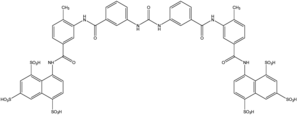Oral lesions are seen in almost all patients with pemphigus vulgaris and are the presenting complaint in 50-70% of patients (1). As these lesions are painful and cause much discomfort, especially while eating some clinicians advise patients to gargle diphenhydramine syrup, which is an effective local anesthetic (2). Based on the role of muscarinic receptors in keratinocyte biology, this letter contests the appropriateness of this therapeutic approach.
It has been shown that in addition to anti-desmosome autoantibodies, the pemphigus serum contains autoantibodies to keratinocyte muscarinic cholinergic receptors (3). These receptors, being expressed mainly in the lower layers of epidermis, control keratinocyte adhesion (4) and their inactivation by pemphigus autoantibodies is believed to elicit intracellular signals that cause disassembly of desmosomes, contributing to acantholysis and blistering (3).
Acetylcholine, synthesized by keratinocytes, regulates keratinocyte adhesion and reverses pemphigus IgG-induced acantholysis in keratinocyte monolayers (2,5). Of note is that suramin sodium, a drug acting on acetylcholine receptors, has been employed to treat pemphigus (3).
Conclusively, given that keratinocyte muscarinic receptors control keratinocyte adhesion and that diphenhydromine possesses potent anti-muscarinic effects (2), gargling of diphenhydramine syrup may slow the healing of the oral lesions of pemphigus and therefore it is best replaced with other topical anesthetics devoid of anticholinergic activity.
References:
1. Wojnarowska F, Eady RAJ, Burge SM. Bullous Eruptions. In: Rook/Wilkinson/Ebling Textbook of Dermatology (Champion RH, Burton JL, Burns DA, Breatnach SM, eds). 6th ed. Vol. 4. Oxford, Blackwell Scientific Publications 1998; 1847-65.
2. Burkohalter A, Frick OL. Histamine, Serotonin & the Ergot Alkaloids. In: Basic & Clinical Pharmacology (Katzung BG, editor). 5th ed. Connecticut: Prentice-Hall International Inc., 1992; 233-7.
3. Nguyen VT, Lee TX, Ndoye A, Shultz LD, Pittelkow MR, Dahl MV, et al. The pathophysiological significance of nondesmoglein targets of pemphigus autoimmunity. Arch Dermatol 1998; 134:971-80.
4. Nguyen VT, Anedondo J, Chernyavsky AI, Kitajima Y, Grad SA. Keratinocyte acetylcholine receptors regulate cell adhesion. Life Sci 2003; 72(18-19):2081-5.
5. Grando SA, Dahl MV. Activation of keratinocyte muscarinic acetylcholine receptors reverses pemphigus acantholysis. J Eur Acad Dermatol Venereol 1993; 2:72-86.
Corresponding address:
M R Namazi MD
Dermatology Department
Shiraz University of Medical Sciences
PO Box 71955-687
Shiraz, Iran
Email: namazi_mr@yahoo.com
COPYRIGHT 2004 Journal of Drugs in Dermatology
COPYRIGHT 2004 Gale Group


